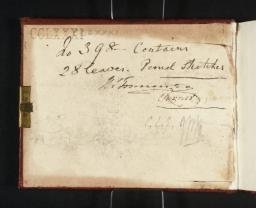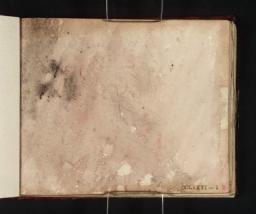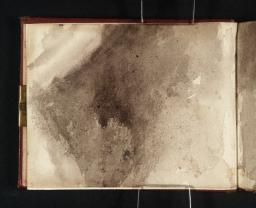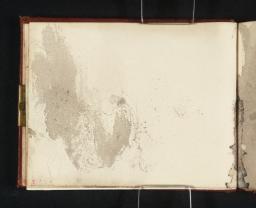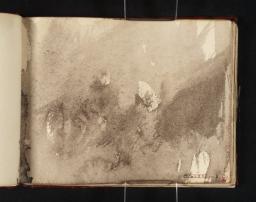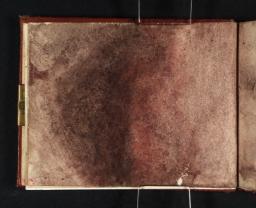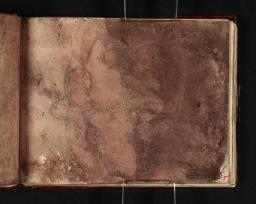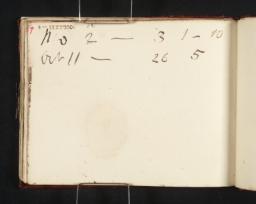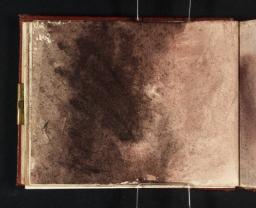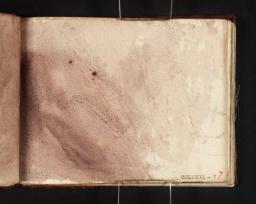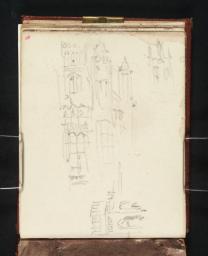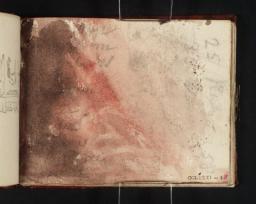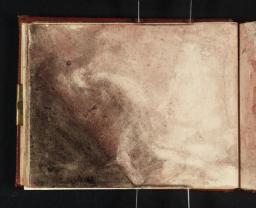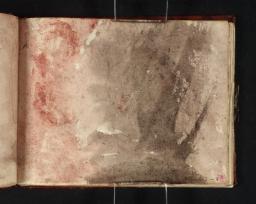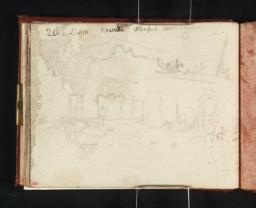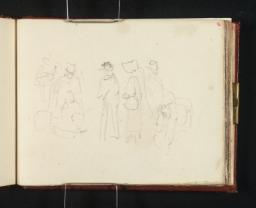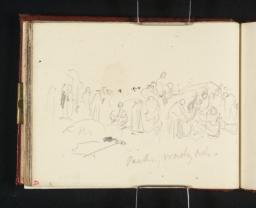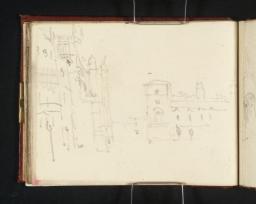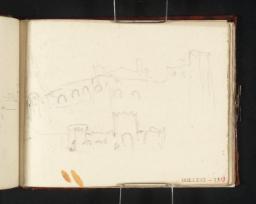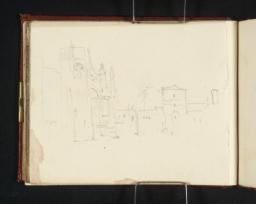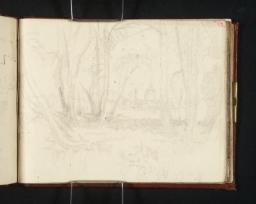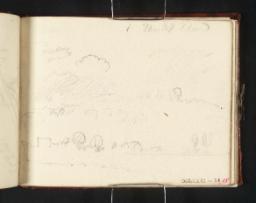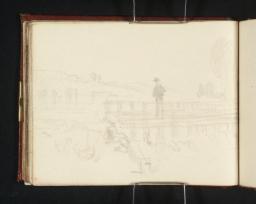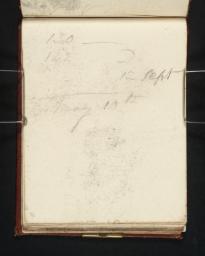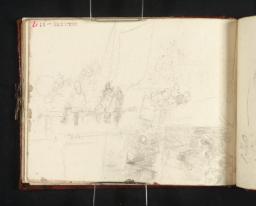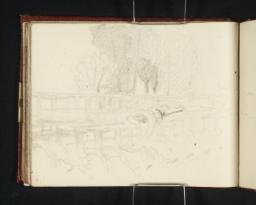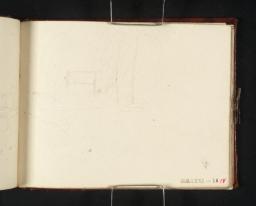Turner Bequest CCLXXXI 1–35
Sketchbook bound in boards, covered in red leather with a brass clasp
35 leaves and pastedowns of white wove paper, with a modern free endpaper of white wove paper at each end; page size 79 x 101 mm
Numbered 398 as part of the Turner Schedule in 1854 and endorsed by the Executors of the Turner Bequest inside front cover (D40746)
35 leaves and pastedowns of white wove paper, with a modern free endpaper of white wove paper at each end; page size 79 x 101 mm
Numbered 398 as part of the Turner Schedule in 1854 and endorsed by the Executors of the Turner Bequest inside front cover (D40746)
Accepted by the nation as part of the Turner Bequest 1856
Exhibition history
References
This small sketchbook comprises a mixture of watercolour studies and pencil sketches, most consistently pencil studies of figures including anglers gathered around a weir; from these Finberg derived the title of the book, which he dated broadly to the early 1830s in his 1909 Turner Bequest Inventory. There are also a few studies of architecture, fishermen and associated coastal scenery, and a few financial and topographical notes.
Some thirteen pages have been worked with watercolour washes to varying degrees: folios 1 recto and verso, 2 recto and verso, 3 recto, 4 verso, 5 recto, 6 verso, 7 recto, 8 recto and verso, 9 recto and 10 recto (D27727–D27729, D40747, D27730, D27731, D27733, D27735, D27736, D27738–D27740, D27742). As Finberg observed: ‘These pages have been prepared with smudges of red and black water colour, the colour being then dabbed and rubbed, with the object apparently of producing suggestions of figures, groups, &c. In some cases these suggestions have been further determined by pencil work.’1
Many of these watercolours appear to represent dark interiors or curtained beds, and pale figures loom out of the shadows in some. However, D27727, D40747 and D27736 and D27738 are barely developed beyond their cursory washes and lack any perceptible subject. The studies of a slightly clearer character appear to have enough in technique, mood and potentially erotic implications in common with those in the Colour Studies (1) and (2) sketchbooks (Tate; Turner Bequest CCXCI b, CCXCI c) to justify bringing the three sketchbooks together in the present catalogue (see the overall Introduction to the grouping). They were first associated in the 1960s by Lawrence Gowing in terms of both the erotic nature of their contents and their loose, improvisational technique.2 (When they address general points concerning Fishing at the Weir and the other two books, Gowing’s and others’ interpretations and comments as cited in this sketchbook’s literature are set out in the general introduction.)
Gerald Wilkinson compared the ‘smudge-drawings’ here, where ‘Turner seems to have been inventing figure groups’, with ‘the manner of [Alexander] Cozens’s blots for landscape composition’3 (for further discussion see the grouping’s Introduction). It should be noted that Ian Warrell, in his comprehensive survey of the erotica scattered through the Turner Bequest, was wary of reading too much into the watercolours here, suggesting that they seem ‘more likely to be Turner’s impressions of the burning of the Houses of Parliament in October 1834 than erotic doodling (with the possible exception of what looks like a seated figure on folio 8 verso [D27739]).’4 While acknowledging Warrell’s reservations, Raphael Rosenberg has compared the general style and some specific details of the washed pages with those in the Colour Studies books (see under folio 6 verso; D27735), concluding that Fishing at the Weir was partly used to continue the sequence once the others had been filled.5
With reference to the event mentioned by Warrell, the washes on folio 8 recto (D27738) appear to have been applied over existing pencil notes and a slight continuation of the pencil sketch of a detail of the old Houses of Parliament on folio 7 verso opposite (D27737). This would imply that all the watercolour washes in the sketchbook cannot predate the autumn of 1834. As well as on D27737, there are pencil sketches of Parliament (also known as the Palace of Westminster) and nearby Westminster Abbey on folios 12 verso–13 recto, 13 verso, and probably 22 verso (D27746–D27747, D227748, D27766), the latter probably being a detail of the abbey’s stonework. These were made in the aftermath of the catastrophic 1834 fire, and can be related to Turner’s slightly unfinished watercolour of The Burning of the Houses of Parliament, of about 1834–5 (Tate D36235; Turner Bequest CCCLXIV 373).6 The view in the watercolour is north over Old Palace Yard, with the Perpendicular Gothic Henry VII’s Chapel at the east end of Westminster Abbey on the left. Visible to the right from that angle was a range housing committee rooms in Italian palazzo style adjoining the south and west sides of Westminster Hall, the prominent gable and pinnacles of which were seen beyond the facade; compare the 1834 coloured print by John Shury of the House of Commons [and] House of Lords before the fire (Parliamentary Art Collection, London). Advancing further to the right was another range, clad in medieval style, south of Westminster Hall. The arcade, committee rooms and courts along this front (see Shury’s print) were largely burnt to the ground, exposing the high western wall of the House of Lords with its semi-circular lunette windows, as shown in D27747. These are clearly seen against flames at the very right of Turner’s watercolour, with indications in the foreground of the silhouette of the castellated King’s Entrance arch in its curving screen at the south-western corner of this part of the complex (see D27737 and D27747). This aspect of the ruins is shown in an 1834 watercolour of the House of Lords from Old Palace Yard by Robert William Billings (1813–1874; Parliamentary Art Collection).7 The House of Lords was soon re-roofed and used as the House of Commons until 1851.8
The sketches in the present book were presumably made at leisure in the aftermath of the fire. Turner could also have referred to his own watercolour of about 1790, View of Westminster with Henry VII’s Chapel, which had remained in his studio (private collection);9 it shows the façades of the abbey and the ‘classical’ wing of Parliament in careful detail; compare D27746–D27747 and D27748 here. Contemporary prints of the fire could also have informed the watercolour. In particular the left side of the colour lithograph of The Destruction of the Houses of Lords and Commons by Fire by William Heath (1795–1840), published on 3 November 1834, shows Henry VII’s Chapel and the houses to its south much as Turner does,10 while The Destruction of Both Houses of Parliament, another 1834 colour lithograph, by Thomas Picken (died 1870), shows the south end of the complex from the same angle as Turner, including the exposed lunette windows (impressions of both: London Metropolitan Archives).
Following the doubts often expressed by earlier scholars, in the course of cataloguing the so-called Burning of the Houses of Parliament (1) and (2) sketchbooks (Tate; Turner Bequest CCLXXXIII, CCLXXXIV), the present author has come to the conclusion that the watercolours extracted from the former (Tate D27846– D27854; Turner Bequest CCLXXXIII 1–9) and the slight pencil drawings scattered through the latter do not relate to the 1834 Westminster fire. The watercolours are instead catalogued as views of the major fire at the Grand Storehouse of the Tower of London in 1841, with the sketchbook renamed Fire at the Tower of London. The pencil sketches in Burning of the Houses of Parliament (2) are more problematic, in that a definite alternative subject remains elusive, but they may show harbours and shipping.
The ‘fishing at the weir’ subjects form the most sustained body of sketches here, drawn with a soft line and an uncharacteristic amount of pencil shading, on folios 15 verso, 17 verso–18 recto, 18 verso–19 recto, 19 verso–20 recto, 20 verso–21 recto, 21 verso, 22 recto, 23 recto and verso and 24 recto (D27752, D27756–D27765, D27767–D27769). The location of this substantial rural weir, with its fence-like wooden superstructure populated by numerous adults and children, is unidentified, but was perhaps somewhere among Turner’s Home Counties haunts such as the Thames Valley; fishing was a favourite hobby of his.11 Gerald Wilkinson has described the sequence as ‘unusually tonal and quiet in atmosphere’,12 thanks in part to the softness of the pencil Turner used. Some of the more general unidentified landscape studies elsewhere in the book may have been made in the vicinity: see inside the front cover, and folios 9 verso, 14 verso, 15 recto, 24 verso and 25 recto (D40746, D27741, D27749, D27751, D27770, D27771).
Mostly towards the end of the book, there are also numerous slight studies of what appear to be commercial fishermen and associated fish markets, with beach, sea and coastal settings, although the locations are as yet undetermined: folios 10 verso, 11 verso, 17 recto, 28 recto, 29 verso, 30 recto, 30 verso–31 recto, 31 verso, 32 verso, 33 recto, 33 verso–34 recto, 34 verso–35 recto, 35 verso and inside the back cover (D27743, D27744, D27755, D27777, D22778, D22780–D27784, D27786–D27791, D40748).
As well as these drawings, there are several pages of typically miscellaneous written notes. Those on folios 6 recto, 16 verso and 25 verso (D27734, D27753, D27772) appear to be of a financial nature; see also folio 22 verso (D27766). Those on folio 8 recto (D27738) are obscured by watercolour washes. There are a few names or place names on folio 9 verso (D27741), apparently unrelated to the landscape sketches there, while on folio 25 recto (D27771) the scrawled notes may be military in character. The fragmentary notes on folio 26 recto (D27773) seem to be topographical, while those on folios 26 verso–27 recto and the verso of the latter (D27774–D27776) certainly are. D27774 and D27775 comprise an itinerary from Geneva in Switzerland to Dijon in France which appears to relate to the tour in 1836 when Turner travelled through the two countries (and on into northern Italy) with his friend and patron H.A.J. Munro of Novar, passing through Dijon on the outward journey before reaching Lake Geneva, as set out in David Hill’s Introduction to the ‘Tour to the Alps 1836’ section of this catalogue.
Because of the connections with the 1834 fire and the 1836 tour, an overall range date of about 1834–6 has been applied; this is in line with the likely dates of the Colour Studies sketchbooks in this grouping.
Warrell 2003, p.28; the present sketchbook is not mentioned in Warrell’s Turner’s Secret Sketches, London 2012.
See also the related print in Katherine Solender, Dreadful Fire! Burning of the Houses of Parliament, exhibition catalogue, Cleveland Museum of Art, Ohio 1984, fig.30.
See caption for the Billings work at ‘Art in Parliament’, www.parliament.uk , accessed 3 April 2014, http://www.parliament.uk/worksofart/artwork/robert-william-billings/house-of-lords-from-old-palace-yard-1834/1660 .
See Anne Lyles, Young Turner: Early Work to 1800: Watercolours and Drawings from the Turner Bequest 1787–1800, exhibition catalogue, Tate Gallery, London 1989, reproduced in colour p.13, pp.21–2 no.2.
Technical notes
How to cite
Matthew Imms, ‘Fishing at the Weir Sketchbook c.1834–6’, sketchbook, April 2014, in David Blayney Brown (ed.), J.M.W. Turner: Sketchbooks, Drawings and Watercolours, Tate Research Publication, September 2014, https://www

